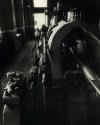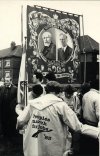
Doncaster, South Yorkshire
Background
Hatfield Main - Brief History
(See the bottom of this page for a brief report)
1908 - 1917
Sometime around 1908, the first shaft sinkers arrived in the Doncaster area. The land to the north east of Doncaster, between Hatfield and Thorne, was rich in coal reserves, with several seams of good quality, low ash content coal. However, due to the geological conditions, getting at these resources proved to be difficult and costly.
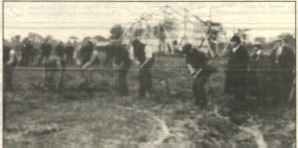
This faded image, taken 14th October 1911, shows the ceremonial cutting of the first turf on the site of Hatfield's shafts.
On the 15th of March in 1917, Thomas Blandford produced a report for the Midlands Institute of Mining describing the difficulties of sinking the shafts for Hatfield Colliery. Presented at the Danum Hotel in Doncaster, his report described the Francois system of cementation being used in the sinking of the Hatfield shafts.
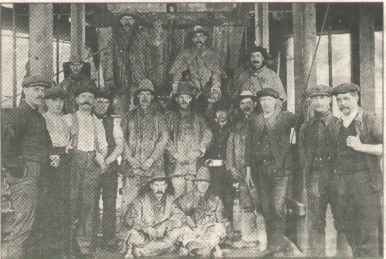
The Hatfield Colliery Shaft Sinkers
The shaft sinkers had to pass through a layer of New Red Sandstone, a heavily porous material, which allowed water from the layers above to pour into the newly sunken shafts at an alarming rate.
The ordinary method of cementation previously employed in the sinking of shafts proved to be totally useless in these conditions. As soon as the cement was applied to the sides of the shafts, it was washed out again by the pressure of the water.
The Francois system used a chemical process, wherein two chemical solution were employed. When mixed, the chemicals produced a gelatinous substance which effectively sealed the pores of the surrounding sandstone layers, allowing the application of the cement.
Pumps were used in the sumps at the bottoms of the shafts to remove any water which seeped into the shafts, and indeed, such pumps are still in use today.
Hatfield's sister colliery, Thorne, was less fortunate with the efforts
to sink the shafts through the water bearing sandstone. From the outset
Thorne was plagued with flooding from the leaking shaft walls until it's
closure in the 1950's, though some would argue even today that the closure
had less to to with water seepage than an effort by management to split
up a militant workforce in what was then, a highly volatile coalfield.
(More about Thorne when the Thorne Colliery page is added to Mining 2000)
Hatfield Main 1916
Click to see full image
1921 and Onwards
By 1921 Hatfield Main was in full production. The nearby railway, canal
and river outlets to the Humber, and the seemingly unlimited market for
coal, offered a bright view of the future for the colliery owners.
From the day the pit opened and onward through the 1920's, a migrant workforce
arrived in the Stainforth and Hatfield area.
By far the largest number of recruits came from the coalfields of Northumberland
and Durham and for many years the villages around Hatfield abounded with
more Geordie speakers than those with a Yorkshire dialect.
A second wave of migrants arrived in 1922, following the collapse of the
1921 strike and the subsequent victimisations in the coalfields further
north.
The same happened again, following the strike of 1926, and then again
during the great depression of the 1930's
1930 Shaft Incident
The luckiest miner ever to work at Hatfield was one of the early shaft examiners. His name was Fred Dunham and his unlucky marra on the fateful day in question was Harry Sutcliff. Both men were swept off the top of the cage and plummeted down the shaft. Harry was killed, but Fred however somersaulted three times bouncing off the guide ropes. Finally he grabbed a rope and, with sparks flying from his hobnail boots as they scraped the shaft walls, he managed to slow his descent. Finally with his feet and legs wrapped round the guide ropes and pulling himself down hand over hand, he emerged into the pit bottom, hands blistered but alive.
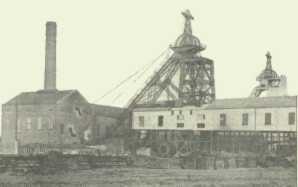
Hatfield Main Colliery in 1939
December 12, 1939
In the fortnight preceeding Christmas of 1939, disaster struck at Hatfield Main.
One man died and over fifty were injured when the cage carrying men to the surface crashed into the headgear. Doncaster Royal Infirmary treated 58 men and boys for their injuries, most suffering from fractured limbs, though ten men and boys were subjected to amputations of their legs.
A verdict of accidental death was returned at the inquest into the death of Daniel Horrigan, described as a stone worker of Arundel Street, Stainforth.
The jury at the inquest, held in The Guild Hall, French Gate, Doncaster, on Friday March 15, 1940, told the Coroner W.H. Carlile they were of the opinion that the safety devices did not cover a sufficient margin of error.
Through the war years
During World War II, Prisoners of War found to have been coal miners in Germany, Poland or elsewhere, were drafted into the pits. A number of such prisoners were sent to Hatfield Main.
Italian P.O.W.s were also set to work on the coal barges at Stainforth canal.
After the war was over, ex-miners/prisoners and stateless persons, such as Ukrainians, Poles, Czechs, Yugoslavians and Germans all found their way into the great fraternity of mining races and peoples.
From Steam to Electricity
In May 1973, the No.2 winding engine was changed from steam to electricity.
In May of 1975, the No.1 winding engine was also converted. The picture shows the immense size of one of the steam engines. In the background is a young Dave Douglass.
No.1 Steam Winding Engine
Click to see full image
Strikes and Strife
The miners of Hatfield Main played a major part in the strikes of '69, '72, '74 and finally in '84, where Tory trickery was used to fool those of lesser gumption into crossing picket lines for the first time at Hatfield.
(See the Further Reading page for information on ordering "A Year Of Our Lives" which tells the story of the Hatfield / Stainforth community during the great strike of 1984)
After the '84 strike, the strength of the NUM at Hatfield declined. By the '90s, after the pit had been bought by the previous management, the Union was no longer made welcome on the site of the colliery.
Participants in and readers of the history of the Doncaster coalfield are at once struck by the repeat of events between the 1926 strike and the 1984/5 strike. It is quite uncanny to discover that not only are the self same scenes repeated but often in the exact same locations.
Retired Doncaster miner P.J.Walentowicz wrote a fascinating little pamphlet titled The General Strike In Doncaster May 1926. This is picked up on by Dave Douglass's little book, Pit Sense Versus The State, A history of the Militant Doncaster Miners. Both books illustrate the remarkable parallels between 26 and 84/5 at least so far as events and reactions of police and miners are concerned. Even more remarkable perhaps the latter is dedicated to George (Bant) Hardy a veteran of both strike campaigns together with those of 1969, 72 and 74 and a thousand local pit rag up and area strikes to boot.
"The worse incident took place at Hatfield on May 12th. A thousand men, mostly miners had blocked the road with the aid of a large tree trunk. At one point vehicles stretched for several hundred yards along the highway. A Newspaper van had been overturned and set on fire... When a large contingent of police, some on horseback, arrived, they were met by a hail of stones and other missiles. The police replied with a baton charge and hand to hand fighting ensued.. more than seventy arrests were made."
We are told that the chairman of the Stainforth Strike Committee received an additional £20 fine "because he was identified as a ringleader of the Hatfield fracas."
The Doncaster collieries were steeped in the politics of the far left and this too was reflected right across the course of the coalfields history.
"The authorities in their mortal fear of the communist insurgents sought out local leaders, particularly those on the left. A Mr. Squeers, the local organiser of ASLEF was such a man. A member of the local Communist Party he was arrested and charged under section 34 of the Emergency Regulations.... He had addressed a mass meeting in Stainforth and urged everyone to stop all scab vehicles (except those carrying bread or milk). Showing the ongoing political bias of the British Courts he was fined £50 and received a three month prison sentence."
Later a Mr. Purvis another Communist Hatfield miner was charged with " an act likely to cause disaffection among the police force." They had come to round him up along with other political subversives and he had called upon the police to join the forthcoming workers revolt when "the workers who are the producers govern the country" He received the maximum punishment the law would allow £100 fine and 3 months hard labour.
Funeral Of Freddie Mathews 1972
Click to see full image
To the best of our knowledge there have been only two NUM banners at Hatfield and both are still in existence. The first was largely designed by the famous Branch Secretary and later MP Mr. (Dick) Kelly. Kelly a Northumbria exile had made the journey south like so many other radical Durham and Northumbrian pitmen to escape the blacklist "up hyem". He had been "proud to sit at the feet of the master" in his youth, The Master being George Harvey an outstanding Geordie coal mining Revolutionary Socialist. Dick at first had despised Parliament and all it stood for, "believing in the bullet and the deed" as means of change. Later he was to enter parliament for Doncaster and become one the longest serving miners MPs ever. After retiring from a lifetime of effort in Parliament he confided that maybe he had been right the first time !
Dick's banner was a single large portrait of Kier Hardy with the inscription "His Vision Is Our Inspiration". The banner was of substantial material and the carrying poles like two sturdy masts, it took quite some controlling in the wind.
Illustrative of our observations on migration; of the eleven Hatfield miners with the original Branch banner seven are miners from elsewhere. Gateshead, South Shields, Easington, Chester-Lee-Street, Harworth .(Notts) and Poland
Cracks appearing in the banner precipitated its safe storage and display at Cusworth Hall museum where it remains.
Drafts for a new banner and the back scene were inspired by the IWW image of a horny handed son of toil against a backdrop of a huge globe. Sadly it didn't quite come off and a coal miner seems to be carrying along a tiny globe on his shoulder. Good mind, but not quite what we had in mind.
Hatfield Main New Banner (Reverse) Unveiling
Click to see full image
Hatfield Main New Banner (Front)
Click to see full image
The miners have long aspired to literacy and self education. Indeed many have brought forth great works , novels based upon the reality of toil and class conflict, histories and political tracts. The impetus to read and to study undoubtedly had two separate and sometimes overlapping influences from the beginning of the C19th. One was Methodism, and the chapel, the tradition of the lay preacher, the Bible and the joint struggles for justice and salvation. The other was Radical Socialism in all its forms from Chartist revolts, to Anarchism and Owenism, radical Socialism and Communism. Many in the latter camp, particularly in the 1920s and 30s had begun in the former camp, and knowing their audience was a mixture of either or both, their Marxism and Socialist missionary work was heavily laced with biblical tales and lessons from the Bible.
The Doncaster Coalfields tradition of propaganda through publication starts with the inception of the coalfield itself and was probably brought from elsewhere. "Old man Parkin" was editor of the immensely popular though thoroughly scurrilous rags The Sylvester and The Butty Squasher. The Butty System was the hated system of subcontracting which paid the Butty Man or contractor for all the work the whole team did and he then decided upon its share out usually allocating himself the Lion share as well as ensuring militants didn't get close to the point of production.
In the 30s came The Mineworker, which was the paper of the miners section of The National Minority Movement. Doncaster being more or less "Red" coalfields it almost certainly had wide distribution round the Doncaster collieries.
In the 50s came the Trotskyist ,Socialist Labour League’s, The Miner with a small but active Trot and fellow traveller readership.
In the 1960’s / 70s The Mineworker was produced from Hatfield Colliery as "organ of The Mineworkers Internationale" a revolutionary miners paper aimed at all the British coalfields and featuring news and events from miners struggles around the world "but mainly Doncaster".
The Mineworker inspired other less political rank and file papers Link Up run by Communist Party members at Bentley Colliery and New Link left-Labourites at Cadeby Main.
Next the Socialist Workers Party brought out what aimed at being a Rank and File miners paper but was very much under their political direction and control The Collier.
In the late 70s the NUM itself brought out The Miner as a national publication , The Yorkshire Miner, the Scottish Miner, The Derbyshire Miner, all followed.
Things went back to an irreverent piss taking politicising with the development of Hot Gossip at Hatfield in the 1980’s . Taking day to day events and the miners own brand of humour and "pillocking" it weighed hilarious pit talk with politics and miners unionism.
Management hated it, to such an extent the Area Director made a very public attack upon it and in so doing inspired the birth of The Link at Yorkshire Main. This was ran along the same lines as the little Hatfield duplication, but on a far grander level, printed on shiny paper with photos and an excellent pit cartoonist David Brennan (we think) it excelled among the miners papers if for nothing else getting the gaffer’s goat. We will demonstrate some examples from these miners publications, pit humour and satire in print long before Viz was ever dreamed of.
Seams Worked
The Barnsley seam was worked from 1921 to 1984. In some areas, the Dunsil seam combines with the Barnsley seam and part of the Dunsil seam was extracted.
The High Hazel seam has been worked from 1927 to December 1993. The Hatfield Coal Company Limited recommenced mining activities within the High Hazel seam in July 1994.
This table shows the seams and the depths
at which they are found
(This information is borrowed from the IMCL report for 1998)
|
Seam
|
Section
cm |
Interval
Metres |
Depth
Metres |
|
Shafton
|
50
|
402
|
|
|
Sharleston Top
|
20
|
45
|
447
|
|
Houghton Thin
|
70
|
56
|
503
|
|
Wheatworth
|
80
|
37
|
540
|
|
Swinton Pottery
|
50
|
24
|
564
|
|
Newhill
|
90
|
17
|
581
|
|
Meltonfield
|
100
|
18
|
599
|
|
Two Foot
|
50
|
8
|
607
|
|
Winter
|
40
|
5
|
612
|
|
High Hazel
|
140
|
22
|
634
|
|
Kents Thick
|
80
|
31
|
665
|
|
Barnsley
|
280
|
38
|
703
|
|
Dunsil
|
70
|
17
|
720
|
|
Flockton Thick
|
160
|
100
|
820
|
|
Fenton
|
50
|
24
|
844
|
|
Parkgate
|
130
|
10
|
854
|
|
Thorncliffe
|
70
|
20
|
874
|
|
Blocking
|
90
|
25
|
899
|
|
Top Beeston
|
140
|
27
|
926
|
The Present
On August 9th 2001 Hatfield Coal Company dramatically announced the closure of Hatfield Colliery. For several weeks the future of the mine hung in the balance. In October 2001 Sir Richard Budge took over the running of the colliery under the name of his new company, Coal Power.
Production.
Under Hatfield Coal Company, production was quoted as the following:
Production at Hatfield is from a single advancing face strategy in the
High Hazel seam.
Annual output is quoted as being between 350,000 and 400,000 t. Production
has to take into consideration market demand and, thus, weekly advance
rates differ between summer and winter.
Production figures for Coal Power will be given when I have them available.
Workforce
Hatfield Coal Company Limited employed a workforce of 205, with an additional
26 persons working from outside contract in the company's coal prep plant.
Coal Power advertised vacancies at the mine in October 2001, so as yet
the actual employment figures at Hatfield are unknown.
Markets
Hatfield's output is presently aimed at the domestic and industrial market.
The mine had won a contract to supply nearby Drax Power Station at Selby
with coal and under Coal Power's management the contract will probably
be fulfilled. However, a message appearing in the Financial Times in October
2001 outlined Mr Budge's plans for an on site coal fired electricity generator,
capable of producing 500 MW and feeding into the National Grid. This is
a system much used in the USA and could provide Hatfield with a secure
future as costs normally accrued in transporting coal no longer apply.
Profit / Loss?
Unfortunately, the financial state of the Hatfield Coal Company was never
open for the scrutiny of anyone not directly concerned with the company.
The problem leading to the company's decline was cited as a "withdrawal
of funding from a Japanese bank". It would appear that the mine had
been given backing from the bank to the tune of £40 million, only
to have the agreement annulled at such short notice that the company could
not find another backer in time to stave off it's creditors.
With the possibility of the mine being tied to an on site power station, the future certainly looks much rosier than it did in late August 2001
.
Into the Future...
Future Prospects.
(From information provided by Hatfield Coal Company Limited. Of course
Coal Power may have different views on the future operation of the mine
and hopefully I will be able to update this page accordingly).
Hatfield has significant resources in both the High Hazel and Barnsley
seams, which could give the mine a significantly long term life.
The mine has a simple layout for the continuation of working in the High Hazel seam, the reserves of which could last a predicted 10 to 12 years.
There are also outline plans for driving two drifts giving access to
the Barnsley seam, which lays some 70m below the High Hazel, with the
prospect of working the 1.9m seam by means of retreat.
If such work was undertaken, the production from the High Hazel seams
would be used to dilute the higher sulphur Barnsley coal.
Update - April 2002.
Coalpower made their plans for Hatfield Colliery
available to the public.
Richard Budge, owner of Coalpower, proposed the building of an
onsite IGCC power generating plant and to develop the area further with
the creation of a "Power Park"
A bold proposal, this plan could create over 1,500 jobs in the Stainforth area, and give Hatfield Colliery a secure long term future.
For more details see the Stainforth 2001 site's Power to the people report on Coalpower's proposals
Update - March 2006.
After two years of uncertainty, since Coalpower closed the doors at Hatfield
in 2004, it now looks as if there really is hope for the survival of Hatfield
colliery.
Earlier this year, as the grey days of winter clung tenaciously onto the
late arrival of spring, Richard Budge announced the formation of his new
company, Powerfuel PLC.
The community of Stainforth and the surrounding areas waited patiently to see if, this time, the plans would amount to more than dust whispering across the spoil heaps.
In the second week of March, the announcement was made that Kuzbassrazrezugol (KRU), one of largest coal producers in Russia, had acquired a 51% shareholding in Powerfuel. The agreement is said to have cost the Russian company £36m, with the understanding that more will invested in the mine over the next year. The plans for the clean power plant are still in place and will require a further investment of £800m from KRU / Powerfuel.
If all goes well, the pit could be in operation as early as next year, 2007. A large portion of the initial investment will have to be spent on the surface, before there is any thought of descending into the mine and starting mining operations. The main offices were badly damaged by a fire, thought to have been caused by an electrical fault, and will be demolished along with most of the remaining buildings.
KRU expect that by the time the colliery has been fully refurbished and
production is at full capacity, possibly by 2009, Hatfield could be producing
around 2m tonnes per year.
Hatfield Main - History
(From Hatfield Coal Company Limited)
1910 - December. Hatfield Main Colliery Company formed by Emerson
Bainbridge.
1911 - 14th October. First sod cut to commence sinking of the shafts.
1916 - 11th September. Sinking of No. 1 Shaft completed.
1917 - 1st April. Sinking of No. 2 Shaft completed.
1921 - Started production in the Barnsley / Dunsil seam.
1927 - January. Colliery incorporated into Carlton Main Colliery
Company. Working of the High Hazel seam commenced.
1928 - 1932. Washery (Blantyre Baum Washbox) constructed by Sherwood-Hunter.
1931 - Canal Staithes constructed - up to 8,000 tons/week transported
by canal.
1934 - Pit Head Baths opened - facilities for 2,800 men.
1939 - 12th December (1:50pm). Overwind at No. 2 Shaft. 58 men
admitted to hospital with serious injuries. One man died in hospital on
14th December.
1944 - 1951. New No. 2 Pit Bottom constructed.
1947 - January. Colliery nationalised and operated by the National
Coal Board.
1948 - June. First diesel locomotive installed underground in Barnsley
seam. The first diesel locomotive was installed in the High Hazel seam
a month later.
1948 - First attempt at mechanisation. Meco Moore coal cutter was
installed on 34's Unit in the High Hazel Seam. This proved to be unsuccessful.
1954 - A jib coal cutter and armoured face conveyor (AFC) in conjunction
with link bars and friction props on 28's unit in the High Hazel seam.
1958 - Underground connection made with Thorne Colliery.
1961 - July. Hydraulic props and link bars with coal cut by Trepanner
on 19's unit in the High Hazel seam.
1963 - August 31st. Hydraulic powered supports introduced onto
65's unit in the High Hazel seam.
1967 - Last hand filled unit at colliery, 20's in the High Hazel
seam, was mechanised. A second machine was introduced onto faces.
1967 - Hatfield and Thorne collieries are merged.
1967 - November 15th. A breach in the supporting wall of a tailings
lagoon floods house in Mayfield Lane, Stainforth.
1969 - September. Skip winding introduced to No. 1 Shaft, replacing
the system of winding coal out of the mine in tubs.
1971 - The Rapid Loading Scheme to load trains with coal destined
for power stations was commissioned.
1973 - July. No. 2 Shaft winding engine is electrified, replacing
steam driven engine.
1975 - May. No. 1 Shaft winding engine is electrified.
1978 - February. Hatfield and Thorne collieries become separate
entities.
1978 - June. First heavy duty face, 30's unit in the Barnsley seam.
1979 - December. The first face (B12's) in the new North East area
of the Barnsley seam commenced production.
1981 - The new Coal Preparation Plant was commissioned.
1981 - May. First retreat face, HR2's in the High Hazel seam.
1983 - August 26th. Working of the Barnsley seam ceased. The last
coal worked was from B15's development drivage.
1986 - February 1st. Hatfield and Thorne collieries merged again.
1989 - February 4th. Highest total weekly saleable output of 26,560
tonnes produced from 3 faces.
1992 - December 19th. Highest weekly output from a single face,
110's unit produced 17,107 tonnes.
1993 - November 18th. Closure of Hatfield/Thorne Colliery on economic
grounds is announced at a reconvened review meeting. All work ceases immediately.
1993 - December 3rd. Production officially ceased.
1994 - January 4th. Interest declared by management team in continuing
the operation of Hatfield Colliery.
1994 - January 25th. Hatfield Coal Company Limited formed.
1994 - March 7th. Last coal cut by British Coal in High Hazel seam,
from F105's unit. Face equipment salvaged.
1994 - Hatfield and Thorne become separate again.
1994 - July 7th. The first coal is cut, by the new operating company,
from F122's Unit in the High Hazel seam.
1994 - October 31st. The Coal Authority take over as licenser of
colliery from British Coal Corporation.
1995 - June 30th. Hatfield Coal Company makes an operating profit
of £2.4 million in it's first year of operation.
1995 - Filming at Hatfield surface for the colliery scenes in the
feature film "Brassed Off".
1997 - April. Redundancy of 31 employees announced, due to a restructuring
plan.
1997 - August 28th. The BBC at Hatfield to film surface and underground
colliery scenes for an episode of "Dalziel and Pascoe"
1998 - November. Hatfield Coal Company acquires freehold of the
colliery site.
2001 - August 9th. Hatfield Coal Company goes into Receivership. Closure of colliery announced. There followed a few frantic weeks while the future of the pit hung in the balance.
2001 - October. Coal Power, Richard Budge's new company takes
over operation of Hatfield Colliery
2002 - April. Coal Power announce publicly plans for Hatfield Colliery to become coal and electricity producing plant. Unfortunately, the required investment was not forthcoming and Hatfield lay dormant for another four years.
2006 - March Earlier this year Richard Budge announced the formation
of his new company, Powerfuel PLC. In the second week of March, the announcement
was made that Kuzbassrazrezugol (KRU), one of largest coal producers in
Russia, had acquired a 51% shareholding in Powerfuel. KRU expect that
by the time the colliery has been fully refurbished and production is
at full capacity, possibly by 2009, Hatfield could be producing around
2m tonnes per year.
Ayle - Betws
- Blenkinsopp
- Clipstone - Daw
Mill - Ellington - Gleision
- Harworth - Hatfield
Main - Hay Royds
Hill Top - Kellingley
- Longannet - Monument
- Maltby -Phoenix
and Hopewell - Prince of Wales -
Rossington
The Free Miners -
The Selby Complex - Thoresby
-Thorne - Tower - Welbeck
- The Nottingham Coalfield
Mining 2000 Conclusions

